|
|
|
Sort Order |
|
|
|
Items / Page
|
|
|
|
|
|
|
| Srl | Item |
| 1 |
ID:
094693
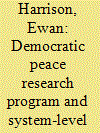

|
|
|
|
|
| Publication |
2010.
|
| Summary/Abstract |
In a path-breaking article, Wade Huntley reinterpreted Kant's pacific union as a systemic phenomenon. This generated a new wave of inquiry into the evolutionary expansion of the democratic peace. The resulting literature examines how the effects of the pacific union vary over time and with the strength of the global democratic community. It investigates the possibility that the democratic zone of peace may spread through spillover effects, socialization dynamics, and positive feedback. In so doing, it has moved democratic peace research beyond the 'separate peace' formulation. Currently, however, this literature has accumulated insights on an ad hoc basis. New hypotheses have been developed and tested without systematically considering how these insights contribute to established knowledge about the democratic peace. This article uses philosophy of science criteria to assess the contributions of the systemic democratic peace literature. It shows how systemic analysis of the democratic peace is progressive in terms of Lakatos's methodology of scientific research programs. The article first considers how Lakatosian methodology has been applied to dyadic democratic peace research. Next, it refines this account of the democratic peace research program to make it more suitable for evaluating the contributions of the systemic literature. The last section shows systemic analysis is compatible with the Lakatosian vision of a cumulative series of theories (monadic-dyadic-systemic) building logically from a core assumption. It then uses the established structure of dyadic inquiry to frame a wide-ranging agenda for a second generation of democratic peace studies.
|
|
|
|
|
|
|
|
|
|
|
|
|
|
|
|
| 2 |
ID:
155845
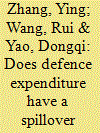

|
|
|
|
|
| Summary/Abstract |
China’s defence expenditure has been growing rapidly along with GDP growth during the past two decades. Meanwhile, the income gap has continued to increase. There are conflicting views regarding whether the defence expenditure is capable of reducing income inequality. Therefore, this paper investigates the existence of any spillover effect of defence expenditure on income inequality, with a special focus on the regional differences among 31 provinces and 7 military regions in China. We extend panel cointegration and the impulse response function by using panel data during the period of 1997–2012. The empirical results show that the defence expenditure has an impact on income inequality, and the effect varies over different regions in China. The defence expenditure has a spillover effect on income inequality in the full sample panel and the southeastern panel. An increase in the defence expenditure does not crowd out social welfare spending due to the high level of economic development and government expenditure. On the contrary, in the northern panel, the effect is opposite because of the unbalanced economic development levels within the panel. Beijing as the capital of China, benefits more from the expansion of defence expenditure thus widening the income gap. In addition, the impulse response analyses further confirm a stronger effect of the defence expenditure on income inequality in the northern and the southeastern panels over a short period.
|
|
|
|
|
|
|
|
|
|
|
|
|
|
|
|
| 3 |
ID:
175906
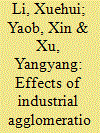

|
|
|
|
|
| Summary/Abstract |
Environmental issues, especially air pollution, have attracted much attention with the development of economy in China. In order to provide a new idea for how to perfect the mechanism of regional joint prevention and control of air pollution, this paper empirically estimates the spatial spillover effect of industrial agglomeration on haze pollution. The results show that the haze pollution has a significant positive correlation with the industrial agglomeration levels in local and neighboring regions. Direct and indirect effects of the industrial agglomeration are all significantly positive, and the latter are much higher than the former. It indicates that the haze pollution is not only affected by the industrial agglomeration in the local region, but also neighboring regions. Furthermore, we find that the direct and indirect effects in central and western China exceed those in eastern China. In addition, the direct and indirect effects of industrial agglomeration in heavily polluting industry are higher compared with non-heavily polluting industry.
|
|
|
|
|
|
|
|
|
|
|
|
|
|
|
|
| 4 |
ID:
188567
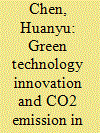

|
|
|
|
|
| Summary/Abstract |
Based on the panel data of 30 provinces in China from 2007 to 2019, this paper investigates the impact of green technology innovation on carbon intensity. Firstly, this paper studies the dynamic evolution and temporal and spatial pattern of China's provincial green technology innovation and carbon intensity. On this basis, the nonlinear spatial Durbin model (SDM) is used to explore the impact of green technology innovation on carbon intensity, and the relevant variables are controlled. The results show that there is a significant spatial agglomeration phenomenon in China's provincial green technology innovation level and carbon intensity. The direct impact of green technological innovation on carbon intensity in local region shows a significant "inverted-U" relationship, that is, when the level of green technological innovation is relatively low, green technological innovation will promote carbon emissions, while when the level of green technological innovation reaches a certain level, this promotion relationship will change into inhibition relationship. From the perspective of interregional spillover effect, green technological innovation also has an “inverted-U″ nonlinear impact on carbon emissions in adjacent regions, that is, the impact of green technological innovation on carbon emissions in adjacent regions is also promoted first and then restrained.
|
|
|
|
|
|
|
|
|
|
|
|
|
|
|
|
| 5 |
ID:
106443


|
|
|
|
|
| Publication |
2011.
|
| Summary/Abstract |
Preliminary results of our survey of 1066 adolescent members of a Canadian Forces (CF) community, comparing the mental health and well-being of CF and civilian youth in a secondary school adjacent to an army base, yielded surprising results. The data were collected in 2008 with an instrument that replicated parts of the National Longitudinal Survey of Children and Youth (NLSCY). Our findings suggested that there are few statistically significant differences between CF and civilian youth on mental health and well-being measures. On the other hand, both the CF and civilian youth scored lower on crucial health and well-being measures than their peers in the national NLSCY sample. This research note attempts to explain these complementary findings, using data from follow-up semi-structured interviews we conducted in 2009/10 with 60 of the CF adolescents. It also considers the possibility of a ''spillover effect'' of military life stressors on civilian youth.
|
|
|
|
|
|
|
|
|
|
|
|
|
|
|
|
| 6 |
ID:
178486
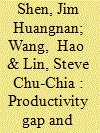

|
|
|
|
|
| Summary/Abstract |
This paper constructs a two-stage sequential game model to shed light on the spillover effect of inward FDI on the efficiency of domestic firms in host countries. Our model shows that, given an optimal joint-venture policy made by foreign firms, the impact of the spillover effect of inward FDI is contingent upon the productivity gap between the domestic firms and foreign ones. In particular, we demonstrate that the spillover effect of inward FDI varies negatively with the productivity gap between domestic low-productivity firms and foreign firms but works in the opposite way for high-productivity firms. This suggests that once the productivity gap widens, the entry of foreign firms will increase the efficiency of high-productivity firms but reduce the efficiency of low-productivity firms. In support of our theoretical model, we provide robust empirical results by using the dataset of annual survey of Chinese industrial enterprises.
|
|
|
|
|
|
|
|
|
|
|
|
|
|
|
|
| 7 |
ID:
163110
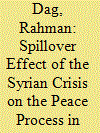

|
|
|
|
|
| Summary/Abstract |
The Kurdish question has been one of the most protracted issues in the political history of Turkey. Given such a long securitization of the Kurdish question, it almost came to an end due to the peace process initiated by the AK Party government and the imprisoned leader of the PKK, Abdullah Öcalan in 2013. Apparently it was not a solid process because it failed immediately after the June 2015 general election. There may have been many internal and external factors explaining the reason why it failed but this paper looks specifically at one of them: the influence of the Syrian crisis on the peace process in Turkey in light of spillover effects and spreading insurgency theories.
|
|
|
|
|
|
|
|
|
|
|
|
|
|
|
|
|
|
|
|
|